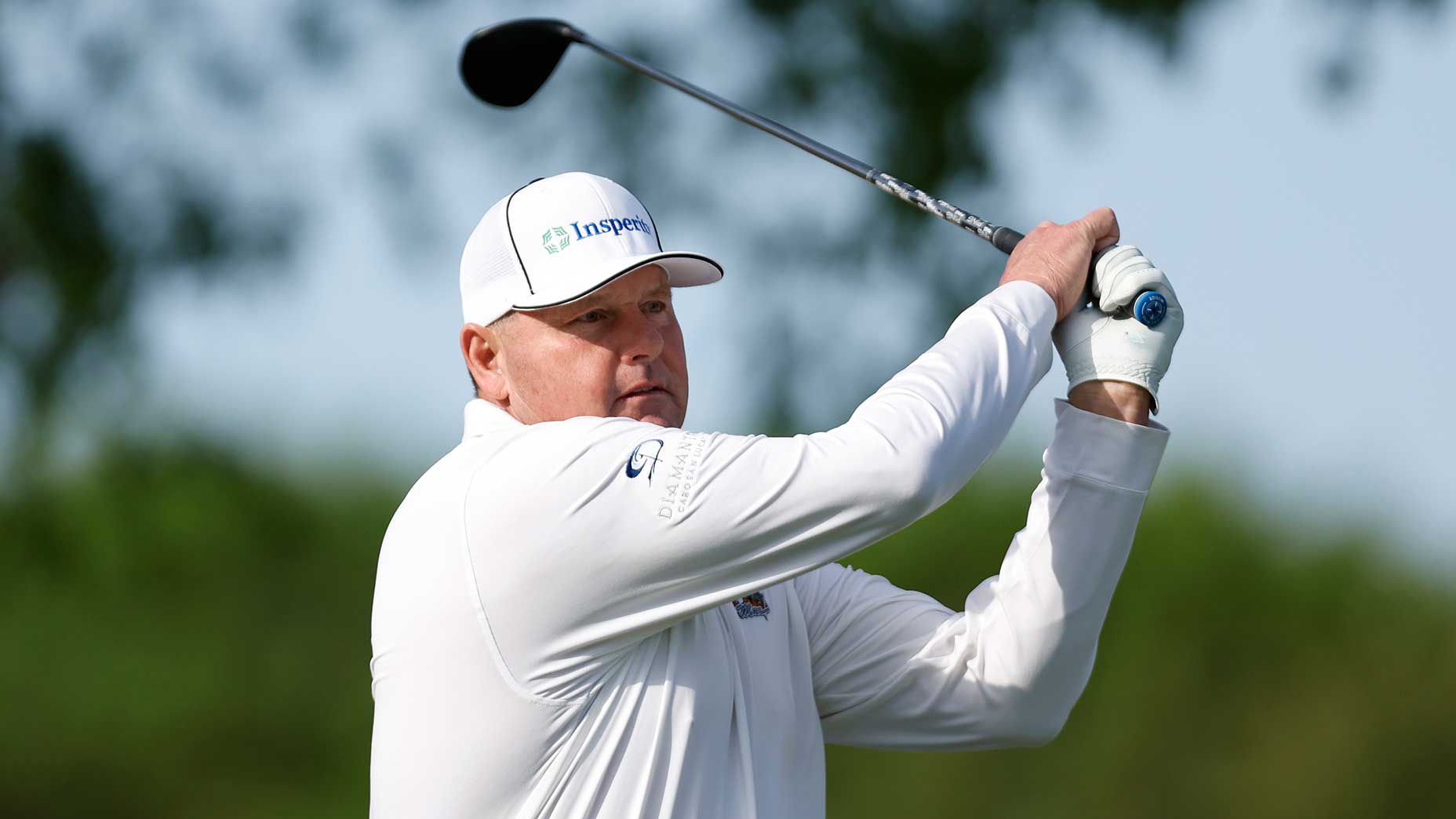This is the fourth installment in our seven-part series, The Modern Pro, in which GOLF.com is breaking down what the landscape of professional golfers looks like in 2018. That includes their swings, their bodies, their brands, and, as you can read below, their lives.
—————————
The modern pro — the PGA Tour player late in the first quarter of the 21st century — is a humanoid subspecies so distinctive he really should have a classification all his own.
Novus golfius, or something like that.
Consider, for example, Jon Rahm, a strapping young man from a generation that has produced many of them. From a distance, in a U.K. airport while waiting to fly back to the United States from the British Open, Rahm is hardly distinguishable from other world-weary young adults in their mid-20s. He’s wearing sweatpants and headphones with a knapsack on his back and flat-brimmed baseball cap pushed over his heavy eyebrows. For the modern pro informality is in, perhaps because his day job demands so much formality from him.
His life is a series of odd juxtapositions. The Tour likes to present itself as a family, but the modern pro will tell you that there’s more alone time than he ever would have imagined. Not necessarily loneliness. Just alone time. Junior golf and college golf doesn’t prepare you for that. The outsized attachment to team play — Ryder and Presidents Cups, the new New Orleans two-man event — is an offshoot of that. The modern pro might have hundreds of thousands of Twitter and Instagram mates, with whom he’s quick to share a private-jet, courtside-seat or #SB2K selfie, but in a quieter, more honest moment he’ll cop to having only a few close friends.
Champion’s Hour: @JonRahmPGA
See what happened immediately after his @DPWTC win. pic.twitter.com/2FXYkm1S3G
— The European Tour (@EuropeanTour) November 21, 2017
Back at the airport, Rahm’s career, identity and status are revealed only upon closer inspection. The boarding pass casually jammed in his pocket signifies his first-class seating. His oft-gloved right hand is darker than his left. The hat reads TaylorMade and he didn’t pay $27 for it at Dick’s Sporting Goods. Quite the opposite.
Rahm, a 23-year-old Spaniard who has played in just six majors, has already made more money than most of his contemporaries will make in their lifetimes: $9 million on the PGA Tour, roughly $5 million on the European tour, plus millions more in endorsement deals from TaylorMade, Rolex and others. Yet we (the fans who ultimately pay him) expect Rahm — when he encounters tournament sponsors and volunteers, reporters and broadcasters, rules officials and Tour officials, airport agents and flight attendants — to act as if he is just another person on this planet of 7.6 billion people, and not the extraordinary golfer that he is.
That push and pull — ordinary v. extraordinary — is at the heart of the conflict that exists in certain modern pros. The highly accomplished modern pro who, say, has been able to keep his place in the top 125 for three or four or five years running. Rahm, it seems, will not have much trouble with the struggle of keeping his card.
Not that you can plan on that. It’s a slow-churning but relentless pressure Tour players face: keeping your card, and allowing for the unpredictable nature of a Tour career.
On the rare occasions when they are in the hunt for a title on Sunday, players will, stealing a page from Tiger Woods, talk about how winning is the whole point of being on Tour in the first place. But what they’re really trying to do is keep their card. That’s goal No. 1. The second is to finish in the top 30 in FedEx Cup points. The top 30 are the elite of these elites. (The Hall of Fame bound are another category altogether.) The top 30 players are going to play more events, which means even more opportunities to make even more money.
They also enjoy the ultimate in luxury: In the quiet of December, they can make their schedules for the following year. The top 30 players know they are going to play the four majors, three or four World Golf Championship events, three or four FedEx playoff events, four tune-up events for the four majors, one or two events in Hawaii, two California events, two Florida events, one or two Texas events, Wells Fargo, the Memorial, Tiger’s July tournament and there it is — your whole season, right there on your iPhone. The modern pro is a planner, or wants to be.
The 100th-ranked player on Tour earns about $1 million in on-course earnings. He is, typically, largely anonymous. Still, even with ordinary endorsements for clubs, ball, shoes, bag and hat, he should be able to make at least $300,000 off the course in a year. Yes, he often has his checkbook out and his credit card in hand. He’s paying between $2,000 and $3,000 for a top-notch caddie roughly 25 times a year, plus about 6 or 7 percent of his on-course earnings.
The agent might get 20 percent of off-course endorsements. The name-brand swing coach might get 2 or 3 percent of on-course winnings. The player’s share of a traveling physiotherapist, whom he shares with four or five other top players, might cost $30,000 a year. Add in hotel charges, air travel (mostly commercial, some private flights), meals, etc. and that $1.3 million can dissolve quickly.
Car tastes and house payments make the difference. Agents and accountants get nervous when a player starts eyeing up houses with elevators, and cars that have their own websites. A phrase you might hear from an agent is, “He’s broke — he just doesn’t know it yet.” The day of reckoning could be a half-decade or more away, or in some cases, just a year or two, and you won’t soon forget it. Because if you play your way off the Tour — everybody’s nightmare — you’ll spend a fortune trying to get back on.
If money isn’t the starting point to understanding the modern pro, it is definitely the most emphatic one. We’re talking about the modern pro, not the modern gentleman golfer from a lost world. The modern pro plays golf for money. The modern pro changes his ball position at address with the goal of hitting more fairways, hitting more greens, making more birdies, making more coin, getting in the top-30 and doing the same thing next year, and the year after that.
But what about the life and times of the modern pro?
He lives, as often as not, in what he calls the southeast. That comprises Orlando, Jacksonville, West Palm Beach and coastal Georgia and South Carolina. Less popular but still common is Dallas, Houston, Phoenix and San Diego. Each of the seven cities cited here should be preceded by the word greater. Urban living is, generally, not a thing for the modern pro. Gated communities are desirable for any variety reasons, one of which is these planned villages nearly always have golf courses and good ranges and a level of security that is comforting when you’re on the road half the year.
The modern pro — often married with young children — has more pressure at home than you might guess. He considers his time on the road as work, and it would be hard to argue that it’s not, even if his work is another person’s play. When he gets home, late on a Sunday night if he has made the final cut of a three-week road trip, his wife sees the return as the start of her break. The modern pro relishes the opportunity to drive the kids to school and to go to their sporting activities, in part because these activities are opportunities for easy points.
The modern pro does not relish — this is a generalization — the expectation that he will discuss his golf game or Tiger’s future (about which he knows next to nothing) or the latest rules debacle with every third person he encounters. The intense interest the modern pro shows in college football and any sport that involves open water is not an accident. Guy needs a break, too.
If he shows up at the tournament on Monday afternoon, he might go to the range. He doesn’t go to the course. Tuesday is his most social day and his most productive one. If he plays nine holes, it’s a lot. He’ll go to the range and try different shafts, tape his swing, workout in a Tour fitness trailer or at a gym at the club, sometimes the hotel. It’s the one night of the week he will actually eat out with his buddies from college or from the Web.com tour. He is reminded how much more social his days in golf’s minor leagues were.
The Wednesday pro-am is a practice-round in disguise, the one chance he has to figure out on which holes to hit driver, and what places you cannot miss. The goal on Thursday is to go low, as low as possible, to take the pressure off on Friday. The goal in Friday is to play well enough to ensure you are playing on the weekend, because you can’t have a six-figure week if you don’t play on the weekend. For the modern pro, money is intertwined with the most important word to the Tour player: status. It’s a packed word. If you have a card, you have status. After that, it’s all a matter of degrees.
Michael Bamberger may be reached at mbamberger0224@aol.com.






